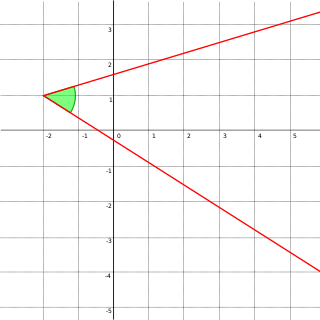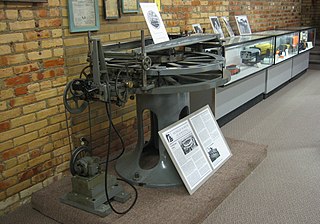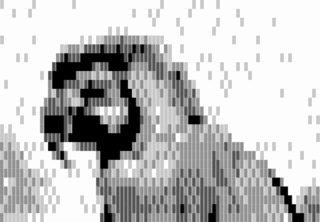Quadrant may refer to:
Quadrant may refer to:

In Euclidean geometry, an angle is the figure formed by two rays, called the sides of the angle, sharing a common endpoint, called the vertex of the angle. Angles formed by two rays are also known as plane angles as they lie in the plane that contains the rays. Angles are also formed by the intersection of two planes; these are called dihedral angles. Two intersecting curves may also define an angle, which is the angle of the rays lying tangent to the respective curves at their point of intersection.

A sextant is a doubly reflecting navigation instrument that measures the angular distance between two visible objects. The primary use of a sextant is to measure the angle between an astronomical object and the horizon for the purposes of celestial navigation.
Arc may refer to:

A vernier scale, named after Pierre Vernier, is a visual aid to take an accurate measurement reading between two graduation markings on a linear scale by using mechanical interpolation, thereby increasing resolution and reducing measurement uncertainty by using vernier acuity to reduce human estimation error. It may be found on many types of instrument measuring linear or angular quantities, but in particular on a vernier caliper which measures internal or external diameter of hollow cylinders.
Norton may refer to:
The Roman triumph was a celebration for a victorious military commander in ancient Rome. For later imitations, in life or in art, see Trionfo. Numerous later uses of the term, up to the present, are derived directly or indirectly from the Roman one.
Hyperbolic is an adjective describing something that resembles or pertains to a hyperbola, to hyperbole, or to hyperbolic geometry.
Edmund Gunter, was an English clergyman, mathematician, geometer and astronomer of Welsh descent. He is best remembered for his mathematical contributions, which include the invention of the Gunter's chain, the Gunter's quadrant, and the Gunter's scale. In 1620, he invented the first successful analogue device which he developed to calculate logarithmic tangents.

A circular sector, also known as circle sector or disk sector, is the portion of a disk enclosed by two radii and an arc, with the smaller area being known as the minor sector and the larger being the major sector. In the diagram, θ is the central angle, the radius of the circle, and is the arc length of the minor sector.
Smiths Group plc is a British, multinational, diversified engineering business headquartered in London, England. It operates in over 50 countries and employs 14,600 staff.

The octant, also called a reflecting quadrant, is a reflecting instrument used in navigation.
In geometry, a quadratrix is a curve having ordinates which are a measure of the area of another curve. The two most famous curves of this class are those of Dinostratus and E. W. Tschirnhaus, which are both related to the circle.
Beta is the second letter of the Greek alphabet.
Sextant may refer to:
The sector, also known as a proportional compass or military compass, was a major calculating instrument in use from the end of the sixteenth century until the nineteenth century. It is an instrument consisting of two rulers of equal length joined by a hinge. A number of scales are inscribed upon the instrument which facilitate various mathematical calculations. It was used for solving problems in proportion, multiplication and division, geometry, and trigonometry, and for computing various mathematical functions, such as square roots and cube roots. Its several scales permitted easy and direct solutions of problems in gunnery, surveying and navigation. The sector derives its name from the fourth proposition of the sixth book of Euclid, where it is demonstrated that similar triangles have their like sides proportional. Some sectors also incorporated a quadrant, and sometimes a clamp at the end of one leg which allowed the device to be used as a gunner's quadrant.

A dividing engine is a device employed to mark graduations on measuring instruments to allow for reading smaller measurements than can be allowed by directly engraving them. The well-known vernier scale and micrometer screw-gauge are classic examples that make use of such graduations.
Reflecting instruments are those that use mirrors to enhance their ability to make measurements. In particular, the use of mirrors permits one to observe two objects simultaneously while measuring the angular distance between the objects. While reflecting instruments are used in many professions, they are primarily associated with celestial navigation as the need to solve navigation problems, in particular the problem of the longitude, was the primary motivation in their development.

Nonius is a measuring tool used in navigation and astronomy named in honour of its inventor, Pedro Nunes, a Portuguese author, mathematician and navigator. The nonius was created in 1542 as a system for taking finer measurements on circular instruments such as the astrolabe. The system was eventually adapted into the Vernier scale in 1631 by the French mathematician Pierre Vernier.

Text-based semigraphics, pseudographics, or character graphics is a primitive method used in early text mode video hardware to emulate raster graphics without having to implement the logic for such a display mode.
An arrow is a projectile launched from a bow.